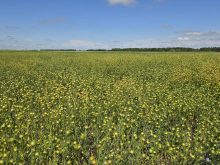German researchers find five genes that the Ustilago maydis fungus uses to manipulate a corn plant’s signalling pathway
Researchers at Germany’s University of Bonn have identified five genes in the fungus Ustilago maydis that cause the disease corn smut.
Corn smut causes kernels to swell into tumour-like galls whose tissues and texture are like mushrooms. They can grow from about six inches to the size of a child’s head. The galls are made up of plant cells, fungal threads and blue-black spores giving the cob a scorched appearance. The charred look is the origin of the fungus’s name Ustilago, from the Latin ustilare, to burn.
Read Also

Genesis Fertilizers seeks government funding
Genesis Fertilizers is actively seeking funding from government and a strategic partner. The company dispelled a rumour that DL E&C has abandoned the project.
The growths are triggered by molecules called effectors that are released by the fungus. They manipulate the corn’s metabolism and suppress its immune system. They promote cell growth and division and interfere with a plant signalling pathway regulated by the plant hormone auxin. This auxin pathway modulates aspects of plant growth and development such as responses to light, organ patterning, root and shoot architecture, vascular development, and cell division and expansion.
The study focused on how the fungus promotes gall growth. The research team searched for the genetic material in the pathogen that enabled it to control the auxin signalling pathway and generate the cell growth.
“At the start, I cloned all 300 candidate effector proteins of U. maydis and performed systematic screens,” said Djamei. “We tested the effector candidates for their potential to target the auxin signalling pathway.”
The research team identified five genes that the fungus used to manipulate the corn’s signalling pathway. The five genes were called Tip1 to Tip5 and they formed a gene cluster. The proteins encoded by the Tip genes bind to a corn plant protein that is known as Topless.
According to the news release, Topless is a central switch that suppresses different signalling pathways in the plant. However, the fungal effectors produced by the five Tip genes override this suppression and they can do this to specifically benefit the fungus, such as overriding the auxin-driven growth signalling pathway. In contrast, other pathways controlled by Topless are not affected.
“How the suppression of the Topless function works is not fully understood but we show evidence for a competition for binding between Tips and Aux/1AAs at the site of Topless,” he said. “I assume that it is about outcompeting via specific levels of affinity while other plant regulators can still bind and recruit Topless. It’s not simply switching it off but rather modulating its function. Figuratively speaking, the fungus acts with surgical precision. It accomplishes exactly what it needs to do to best infect the corn plant.”
The relationship between Topless and the Tip genes exists not only in corn but in a similar form in all other land plants. The researchers could show that the Tip effectors of the fungus also interfere with the auxin signalling pathway of other plant species. Djamei said that the evolutionary development led to optimization and selection of variants which generate modifications in favour of the pathogen while not triggering the host response that would lead to a defense reaction.
The galls, while unsightly, are edible and in Mexico they are known as the delicacy “huitlacoche,” which is often eaten as a filling in quesadillas and other tortilla-based foods as well as an ingredient in soups.
While corn smut cannot be controlled with fungicides, some beneficial ways to contain the disease include crop rotations and minimizing crop damage such as that caused through mechanical injury. Damaged plants with open cuts can make corn easily accessible to fungus spores, inviting infection.
Clearing the corn field of debris after harvest can help with some control because the teliospores of corn smut overwinter in the soil. Using fertilizer with low nitrogen levels or limiting the amount of nitrogen in the soil is an additional way to help control corn smut.
Some research has been done to genetically modify corn to be resistant to U. maydis and the mutants showed a moderate resistance to the fungus. But further work is needed to analyze the performance of the mutant variants against pathogenic insects and other fungi to rule out unintended consequences or any substantial trade-off effects.
Going forward, a new research paper is in preparation on auxin-inducing effectors and goes deeper into the mechanisms behind this biology.
“We also have many other interesting effectors with functional links to various pathways which we will work on further and (eventually) have them published.”
The research was published recently in the journal New Phytologist.















